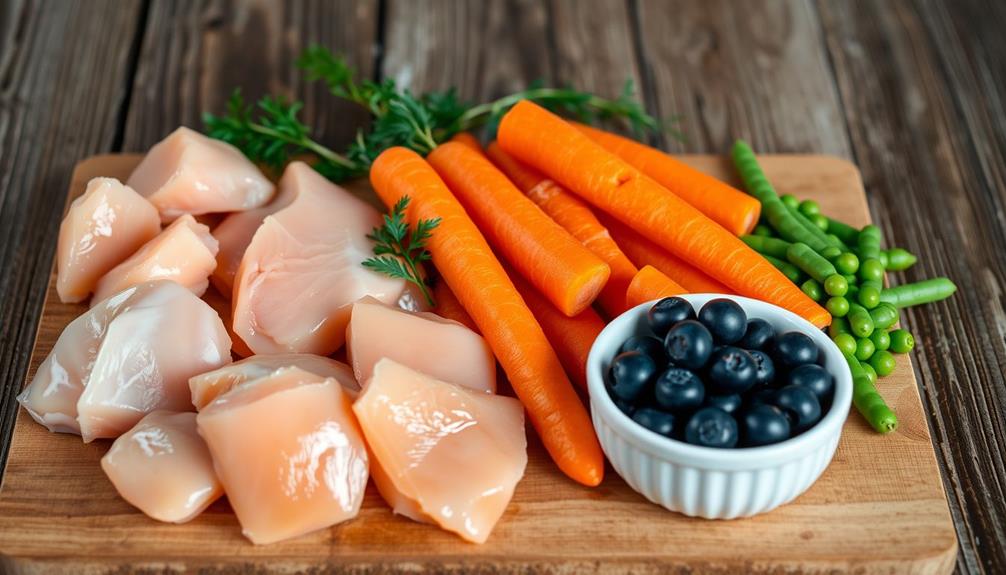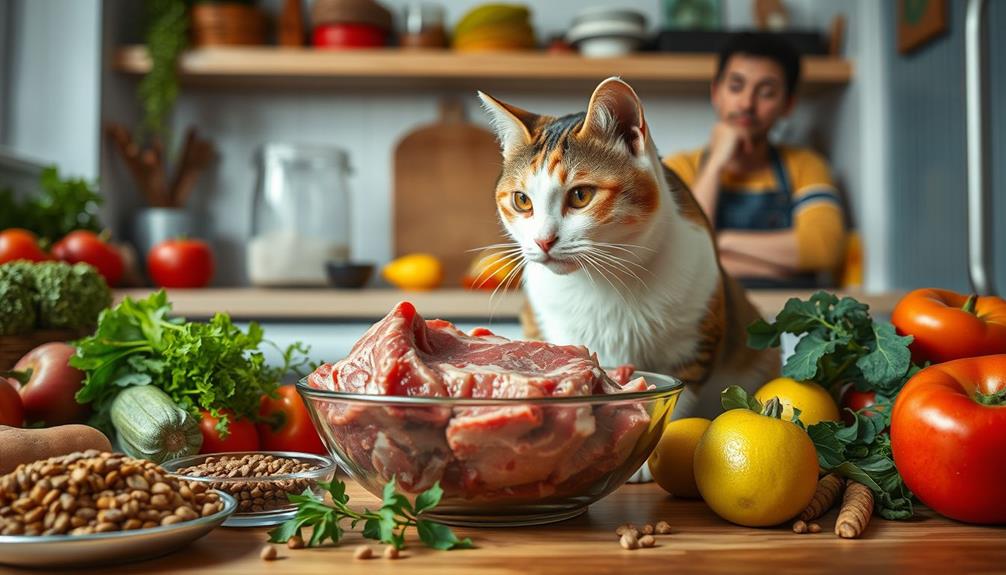When considering raw food for your cat, there are several safe options you can offer. Lean sources like chicken and boneless beef provide high protein and essential nutrients like taurine. Organ meats, especially liver, are rich in crucial vitamins, while fish such as salmon offers beneficial omega-3 fatty acids. Always prioritize hygiene by sourcing high-quality meat and avoiding cross-contamination. Remember, a well-balanced raw diet should include a variety of muscle meats, organ meats, and ground bones. To guarantee your cat remains healthy, you might find it helpful to explore more about nutritional balance and safe practices.
Key Takeaways
- Safe raw food options for cats include lean proteins like chicken and boneless beef, which provide essential nutrients.
- Organ meats, particularly liver, are nutrient-dense and supply vital vitamins A, D, E, and K.
- Fish, such as salmon, offers omega-3 fatty acids but should be fed in moderation to avoid toxicity.
- Always source high-quality meat from reputable suppliers to minimize contamination risks.
- Consult with a veterinarian to ensure the raw diet is balanced and meets all nutritional needs.
Understanding Raw Food for Cats
Understanding raw food for cats can be a game-changer for pet owners looking to provide a more natural diet. A raw food diet typically involves feeding uncooked animal products, like raw meat, organ meat, and ground bones, closely resembling what wild feline predators consume.
Since cats are obligate carnivores, they require a high-protein, high-moisture diet to meet their nutritional needs. This includes specific nutrients such as taurine and vitamins A, D, and B. Additionally, it's crucial to evaluate the health risks of raw diets due to potential pathogens present in raw meat.
However, while raw diets can offer important nutrients, the lack of balanced formulations in homemade options can lead to deficiencies. It's important to collaborate with veterinarians when preparing these meals to guarantee they're nutritionally adequate.
You can also evaluate commercially prepared raw food options, which often meet WSAVA guidelines and undergo feeding trials for safety.
But be cautious—raw meat can carry foodborne pathogens that may harm your cat. Prioritizing high-quality ingredients is essential to minimize health risks.
Benefits of Raw Meat

The allure of raw meat lies in its ability to provide a natural, nutrient-rich diet that can greatly benefit your cat's health. Raw meat serves as a source of high-quality protein, essential for your feline's energy and overall liveliness. It's packed with important vitamins and minerals, including taurine, which is essential for maintaining heart health and proper vision in cats.
Additionally, including healthy dog snacks in your pet's diet can complement their nutritional needs and promote overall wellness.
One of the significant advantages of raw meat is its high moisture content, which helps improve hydration levels. This is crucial for supporting kidney function and urinary health. When you incorporate raw meat into your cat's diet, you may notice improved digestion and nutrient absorption. The natural form of these ingredients can be more easily recognized and utilized by your cat's digestive system.
Additionally, feeding raw meat can enhance your cat's coat condition. The fatty acids found in certain meats, like fish, contribute to a healthy and shiny coat.
Safe Raw Meat Options
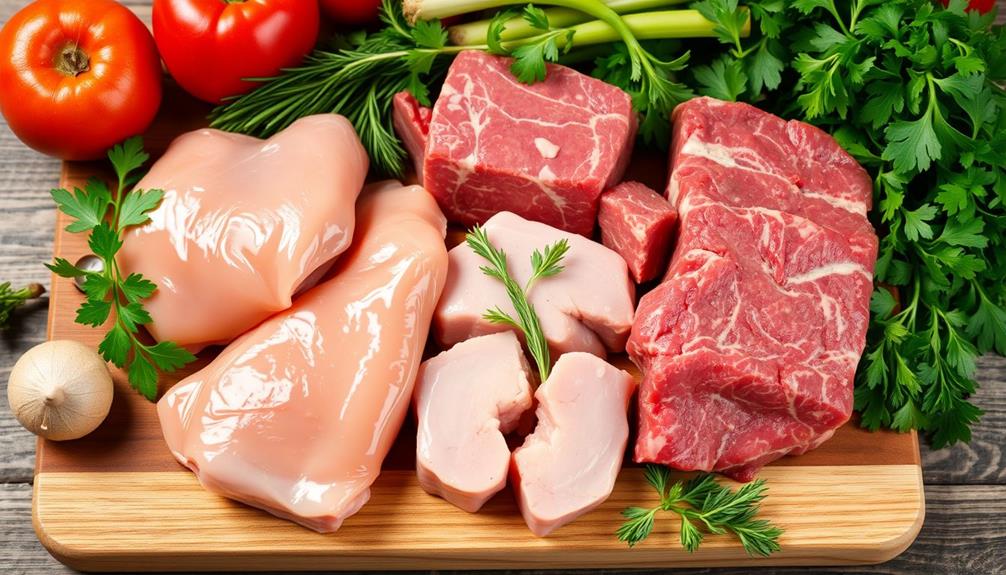
When it comes to choosing safe raw meat options for your cat, several choices stand out for their nutritional benefits. Chicken is a fantastic lean protein source that supports energy and digestion, making it a staple in many raw diets. Additionally, incorporating high antioxidant foods can help enhance your cat's overall health.
Boneless beef is another excellent option, offering rich protein and taurine, essential for your cat's heart health and vision.
Don't overlook organ meats like liver, which are highly nutrient-dense. They provide essential vitamins A, D, E, and K that contribute to your cat's overall health. Additionally, heart tissue boosts taurine levels, critical for feline well-being.
If your cat enjoys fish, such as salmon, it can be a good source of omega-3 fatty acids, promoting healthy skin and coat. However, be sure to feed fish in moderation to avoid toxicity from excessive nutrients.
Preparing Raw Meat Safely
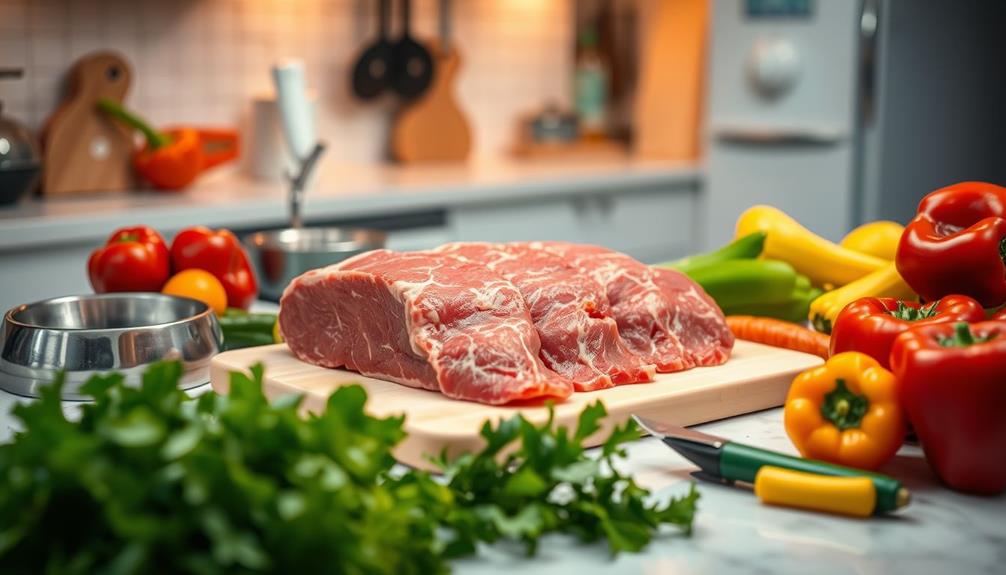
When preparing raw meat for your cat, it's vital to prioritize hygiene and safe sourcing.
Always choose high-quality meat from reputable suppliers to reduce the risk of contamination, as outlined in Ultimate Hamster Care Guide regarding food safety for pets.
Use separate utensils to prevent cross-contamination.
Hygiene and Preparation Practices
Proper hygiene and preparation practices are essential for safely handling raw meat for your cat. Start by washing your hands thoroughly after handling raw meat, and always sanitize all surfaces and utensils used during preparation.
To prevent cross-contamination, keep raw meat separate from other food items. Avoid rinsing raw meat, as this can spread harmful pathogens throughout your kitchen. Additionally, consider using a dedicated cutting board for raw meat to further minimize contamination risks, similar to maintaining cleanliness with air purifiers to enhance performance air purifier maintenance dos and don'ts.
Using gloves while preparing raw meat is a smart move, especially if you have cuts or open wounds on your hands, as it helps reduce the risk of transferring bacteria. Before you begin, verify all equipment—like cutting boards and knives—are sanitized to maintain a hygienic environment.
When storing raw meat products, keep them in the freezer until you're ready to use them. Thaw them in the refrigerator rather than on the counter to minimize bacterial growth and guarantee food safety.
Safe Sourcing of Meat
Choosing the right meat for your cat is just as important as preparing it safely. To guarantee you're sourcing meat that's safe and healthy, follow these guidelines.
| Aspect | Best Practices | Notes |
|---|---|---|
| Sourcing | Choose high-quality products | Buy from reputable suppliers only |
| Handling | Use sanitized utensils | Prevent cross-contamination |
| Inspection | Regularly check for freshness | Discard any spoiled products |
Always avoid purchasing meat from unknown sources, as they might expose your cat to harmful bacteria and pathogens like Salmonella or E. coli. To further minimize these risks, freeze raw meat for at least 24 hours before feeding to eliminate parasites like Toxoplasma gondii. When preparing food, make sure to wash your hands thoroughly after handling meat and sanitize your work surfaces. This way, you'll greatly reduce the chances of cross-contamination with other foods. Inspect meat regularly for freshness, discarding anything with unusual odors or discoloration. With these practices, you can confidently provide your cat with safe, nutritious meals.
Nutritional Balance in Raw Diets

Balancing nutrients in a raw food diet for your cat is essential for their health and well-being. To achieve complete and balanced nutrition, you need to include a variety of animal products, such as raw muscle meat, organ meat, and ground bones. Each component plays a significant role in providing the necessary nutritional value your cat requires.
It's also important to take into account the potential financial implications of dietary changes, including the costs associated with high-quality raw ingredients, as seen in financial considerations for elderly care. Cats need specific nutrients like taurine, arachidonic acid, and vitamins A, D, and B to maintain overall health and prevent nutritional deficiencies. If your cat's diet lacks these essential nutrients, it could lead to serious health issues, including nerve and brain problems. This makes it vital to formulate their raw diets carefully.
While homemade raw diets can be tempting, they often lack the proper balance without veterinary guidance. It's best to consult with a veterinarian or a veterinary nutritionist to create a tailored raw diet that meets your cat's specific health needs and lifestyle.
Transitioning Your Cat to Raw Food

Shifting your cat to a raw food diet can be a rewarding journey, but it requires careful planning and patience. Start by converting your cat to raw food gradually; mix 25% raw food with 75% of their current diet. Incorporating essential oils for respiratory health can also support overall wellness during this change.
Increase the raw proportion by 25% every 2-3 days to help prevent digestive upset. During this adjustment, it's vital to monitor your cat's health closely. Keep an eye out for signs of gastrointestinal distress, such as vomiting or diarrhea, and adjust the diet accordingly.
If you have a kitten, consider starting the change after they're 20 weeks old, as they're generally more adaptable to new dietary changes. Always verify that the raw food you offer is of high quality, sourced from reputable suppliers, and free from harmful pathogens. This promotes safety during the adjustment.
Additionally, consult with a veterinarian or a veterinary nutritionist to confirm that the new raw diet meets all of your cat's nutritional requirements. A balanced diet is fundamental for maintaining your cat's health and well-being as they adjust to their new eating habits.
Commercial Raw Food Products

When choosing commercial raw food products for your cat, you'll find a variety of options like frozen, freeze-dried, and raw patties.
These products are designed to meet specific nutritional standards, ensuring your cat gets the right balance of nutrients.
Additionally, it's important to take into account financial planning for pet care expenses, as maintaining your cat's diet can be a part of your overall budget.
Plus, they usually come with safety guidelines to help you handle them properly and reduce the risk of contamination.
Types of Commercial Products
In recent years, the popularity of commercial raw food products for cats has surged, offering pet owners convenient and nutritious options. These commercial raw diets typically come in frozen or freeze-dried forms, designed to minimize pathogen risks while guaranteeing balanced nutrition. Many of these raw cat foods meet AAFCO standards, ensuring they contain essential nutrients for a complete diet.
This trend mirrors the growing interest in high customer service ratings among pet food brands, as owners seek reliable and trustworthy products for their pets.
Some brands provide premixed formulas that allow you to easily add raw meat to a blend of vegetables, vitamins, and minerals, making meal preparation simple. It's important to choose products formulated by veterinary nutritionists, as they understand the specific dietary needs of cats. This expertise helps guarantee that your cat receives all necessary nutrients.
When handling these raw products, remember to follow safe-handling guidelines to prevent cross-contamination and maintain hygiene. This step is vital in reducing the risk of pathogens that can jeopardize your cat's health.
Safety Standards and Guidelines
Guaranteeing your cat's safety while feeding them commercial raw food products involves understanding and adhering to established safety standards and guidelines. Here are three key points to take into account:
- AAFCO Standards: Make certain the raw food diets you choose meet Association of American Feed Control Officials (AAFCO) standards. This guarantees the food is nutritionally complete and balanced for your cat. Following these guidelines is akin to the importance of quality assurance in software development, ensuring everything meets high standards.
- Safety Protocols: Opt for raw food from reputable brands that follow strict safety protocols. They should regularly test for pathogens like Salmonella and E. coli to minimize health risks.
- Veterinary Formulation: The World Small Animal Veterinary Association (WSAVA) guidelines recommend selecting diets formulated by veterinary nutritionists. This guarantees ideal safety and nutrition for your furry friend.
Additionally, always look for products with clear safe handling instructions. Proper handling can greatly reduce the risk of cross-contamination during storage and feeding.
Alternatives to Raw Meat
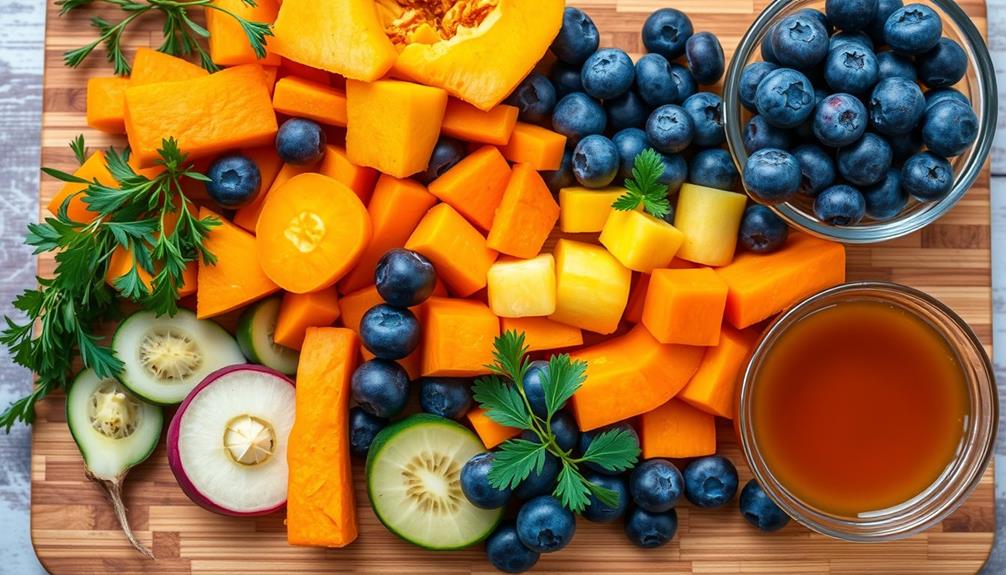
For pet owners seeking alternatives to raw meat, several options provide balanced nutrition while reducing health risks.
Cooked meat options, like steamed or boiled chicken or turkey, serve as safe alternatives to raw food, giving your cat essential nutrients without the threat of bacterial contamination.
If you're looking for convenience, freeze-dried options are a great choice. These products retain their nutritional content while eliminating harmful bacteria, making them a practical and safe choice for your furry friend.
High-quality wet food also stands out as a balanced alternative, providing high protein content along with moisture, which is essential for your cat's hydration and overall health.
While dry cat food can be a staple, it often contains higher carbohydrate levels, so it's important to select high-quality kibble that still meets your cat's nutritional needs.
Best Practices for Raw Feeding

When introducing raw food into your cat's diet, it's crucial to do so gradually. Start by mixing 25% raw food with 75% of their regular food, then increase the raw portion by 25% every 2-3 days. This method helps prevent digestive issues and guarantees your cat adjusts smoothly.
Here are some best practices for feeding raw food:
- Source high-quality meat: Buy from reputable suppliers to minimize contamination risks and guarantee safety.
- Maintain hygiene practices: Always sanitize preparation areas, use gloves, and thoroughly clean utensils to avoid cross-contamination with harmful bacteria.
- Schedule veterinary check-ups: Regularly monitor your cat's health to assess their response to the raw diet and adjust portions based on their body weight and overall well-being.
Additionally, verify that the raw diet is nutritionally complete by consulting with a veterinarian or a veterinary nutritionist.
Homemade diets can often lack crucial nutrients, so it's important to identify safe options that meet your cat's dietary needs. By following these practices, you can confidently shift your feline friend to a raw food diet.
Frequently Asked Questions
What Raw Foods Are Safe for Cats?
When considering safe raw foods for your cat, think about options like chicken, turkey, and liver. Just guarantee you source them from trusted suppliers and maintain proper hygiene while preparing their meals.
What Is the Alternative to Raw Food for Cats?
Imagine your cat enjoying a gourmet meal. Instead of raw food, you can opt for high-quality wet food or cooked meat, ensuring they get balanced nutrition without the risks of harmful bacteria. It's both safe and satisfying.
Can I Feed My Cat Any Raw Meat?
You can feed your cat certain raw meats, but it's essential to choose safe options. Start with small amounts to avoid digestive issues, and always guarantee the meat is fresh and free from harmful bacteria.
Do Vets Recommend a Raw Diet for Cats?
Most vets don't recommend raw diets for cats due to health risks and nutritional concerns. If you're considering this diet, it's essential to consult a veterinary nutritionist to make certain it's safe and balanced for your cat.
Conclusion
So, while it might seem crazy to think of feeding your cat raw food—after all, aren't we the ones who cook everything?—it's actually a natural choice for their diet. By offering safe raw options and ensuring nutritional balance, you can give your feline friend a diet that aligns with their instincts. Just remember, you're not the one eating it! Embrace the irony and enjoy watching your cat thrive on a meal that's as close to nature as it gets.

